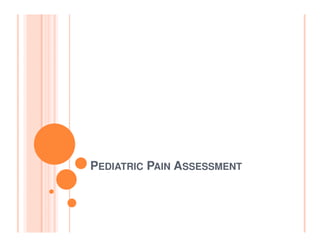Report
Share
Download to read offline

Recommended
More Related Content
What's hot
What's hot (20)
Bag and Mask Ventilation By Sakun Rasaily @Ram K Dhamala

Bag and Mask Ventilation By Sakun Rasaily @Ram K Dhamala
NICU CONCEPTS, STAFFING,PROTOCOLS, PHYSICAL LAYOUT

NICU CONCEPTS, STAFFING,PROTOCOLS, PHYSICAL LAYOUT
Viewers also liked
Viewers also liked (20)
Pediatric pain protocol Al Razi Anesthesia department Kuwait

Pediatric pain protocol Al Razi Anesthesia department Kuwait
Providing quality pediatric pain management during end of life care

Providing quality pediatric pain management during end of life care
Pain- definition, nature, signs& symptoms, types, assessment & management

Pain- definition, nature, signs& symptoms, types, assessment & management
Similar to Pediatric pain assessment
Similar to Pediatric pain assessment (20)
Clinical Assessment of Children and Adolescents with Depression

Clinical Assessment of Children and Adolescents with Depression
5. Clinical Assessment of Pain in Adults and Children.ppt

5. Clinical Assessment of Pain in Adults and Children.ppt
Chapter 12Somatic Symptom Disorders and Dissociative Disorde

Chapter 12Somatic Symptom Disorders and Dissociative Disorde
Bipolar disorder in the school setting naa conference 

Bipolar disorder in the school setting naa conference
Pediatric pain assessment
- 2. PAIN ASSESSMENT Get detailed assessment History of primary illness Description of pain Experience with pain medications Use of non-pharmacologic approaches Parent personal experience with pain meds Social & spiritual factors
- 3. PAIN ASSESSMENT TOOLS: SCALES DO NOT ALWAYS REPRESENT MULTIDIMENSIONAL ASPECT OF PAIN
- 4. BIRTH - 2 YEARS Pain Perception Neonates as young as 24- weeks feel pain Ascending nerve tracts develop earlier than the pain inhibiting nerve tracts meaning that neonates may experience a greater intensity of pain than older children Neonates exposed to repeated painful stimuli show increasing sensitivity Neonatal/Infant Pain Scale (NIPS)
- 5. BIRTH - 2 YEARS (CONTINUED) Cognition No “understanding” of pain and unable to provide a self-report 12 to 18 months, beginning of reasoning and language (1- or 2-word statements) Major cognitive processing through senses (eyes, ears, hands) CHEOPS (1-7 years) Looks at types of pain behavior: cry, facial, verbal, torso, touch and legs.
- 6. 2 - 4 YEARS CNS fully developed Development of autonomy continues Significant language development Limited logic and reasoning Self-centered thought process Visual analog (Wong- Baker Faces)
- 7. 7 - 11 YEARS Logic and reasoning far more developed Imagination and creativity Finalism and concept of death Number pain scale (scale 1-10)
- 8. Adolescents (11+ years) Cognitively adults Same pain assessment methods as adults Abstract thinking and understanding hypothetical situations Emotional needs Include them in the process Respect their privacy Respect their pain reports
- 11. Pain Assessment Hospitals should use a standard pain scale for the various age groups to allow continuity. Self report scores (e.g. numerical rating scale) can mislead. A score of 4 may denote severe pain to one adolescent while 8 may be severe to another. Pain can be worsened by anxiety, depression and spiritual crisis. We must consider this in our assessment.
- 12. References Bieri D, Reeve RA, Champion GD, Addicoat L, Ziegler JB. The Faces Pain Scale for the self-assessment of the severity of pain experienced by children: development, initial validation, and preliminary investigation for ratio scale properties. Pain. 1990; 41(2):139-50. Friedrichsdorf SJ, Kang TI. The management of pain in children with life-limiting illnesses. Pediatric clinics of North America. 2007; 54: 645-672. Tomlinson D, Baeyer CL, Stinson JN, Sung L.A systematic review of Faces scales for the self-report of pain intensity in children. Pediatrics. 2010; 126: e1168.